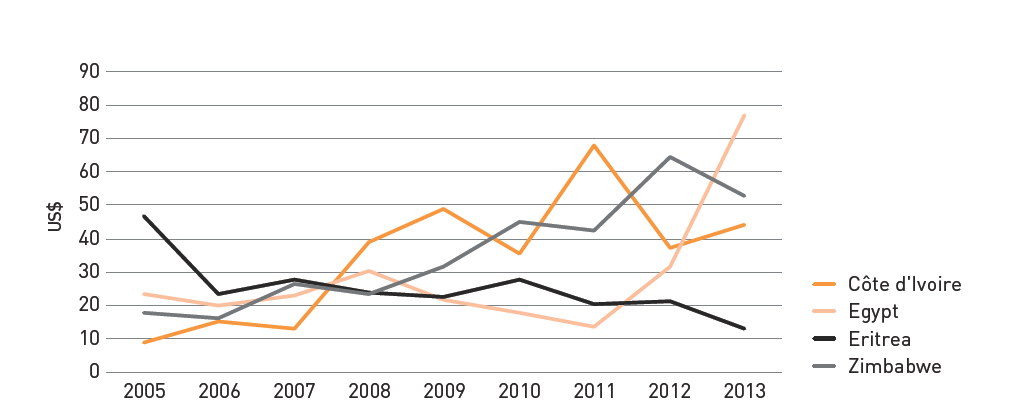Humanitarian assistance to fragile states is often volatile and unpredictable
 Aid provided to fragile and conflict-affected states is often volatile and unpredictable. Across all 70 countries classified as fragile states in 2013, 36 experienced four or more aid shocks – a 15% or more fluctuation in aid from one year to the next – between 2005 and 2013. For some countries aid fluctuations are substantial. For example, the four long-term fragile states Côte d’Ivoire, Egypt, Eritrea and Zimbabwe have each experienced more than five shocks in the past eight years.
Aid provided to fragile and conflict-affected states is often volatile and unpredictable. Across all 70 countries classified as fragile states in 2013, 36 experienced four or more aid shocks – a 15% or more fluctuation in aid from one year to the next – between 2005 and 2013. For some countries aid fluctuations are substantial. For example, the four long-term fragile states Côte d’Ivoire, Egypt, Eritrea and Zimbabwe have each experienced more than five shocks in the past eight years.
The transition from conflict or political fragility to stability takes time. In 2013, 72% of official humanitarian assistance to fragile states went to long-term recipients, defined as those that have received an above-average share of their official development assistance (ODA) in the form of humanitarian assistance for eight years or more between 1999 and 2013.
The type and predictability of financing, as well as the complementarity of responses to immediate crises and ongoing developmental support, are as crucial as overall volumes. Such volatility emphasises the importance of having effective rapid response mechanisms and anticipatory, sustainable and multi-year financing sources and modalities.
Download the data in Excel and CSV format
Notes
ODA excludes debt relief and humanitarian assistance.
Source
Development Initiatives based on FFP Fragile States Index, OECD DAC and World Bank.
Related content
Priorities for the UK’s incoming Secretary of State Alok Sharma
As Alok Sharma takes office as Secretary of State, DI's Amy Dodd sets out key priorities for the UK and its global development agenda.
From review to delivery on the Global Goals – what should the immediate priorities be for the UK government?
On 26 June, the UK government published its Voluntary National Review measuring delivery against the Global Goals - but does it accurately capture progress?
Three priorities for the High-level Political Forum 2019
DI Director of Partnerships & Engagement Carolyn Culey sets out three key priorities for closing the gap between the poorest and the rest at HLPF 2019